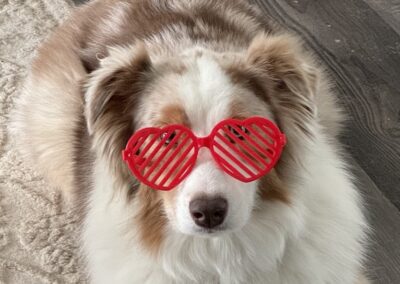[vc_row][vc_column][trx_section box=”yes”][trx_title align=”center” color=”#d9ae4c” weight=”700″]
From the Trenches
[/trx_title][trx_title align=”center” color=”#d9ae4c” weight=”700″]
A Vet’s Story
[/trx_title][trx_title type=”4″ align=”center” color=”#434544″ weight=”700″ bottom=”mini”]by Dr. Eileen Savier CVA, CVCH[/trx_title][vc_column_text]
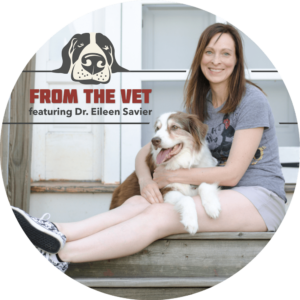
Presenting Complaint (from our VET): NOT Heeding Discharge Instructions
In the past week, I have had to repair surgeries that were done at our office because discharge instructions were not followed. One was a spay in which the dog was too active and left without an e-collar and the second was a biopsy and the dog was left without an e-collar. With any surgical procedure verbal discharge instructions are given in addition to written instructions. Let’s review how these two cases ended up back in the surgery suite.
Any one who has owned a puppy has been through the process of a spay (or neuter) procedure. Both of these surgeries are commonly seen as routine and owners spend little time considering the anesthetic risks or the post-operative care. These are in fact, major surgeries! They are also common and come with a relatively low anesthetic risk for most patients. The post operative recovery period is 10-14 days and is done with the owners not the veterinary staff. For a spay specifically we are entering the abdominal cavity, removing two ovaries and the entire uterus. The abdomen is then closed back up in three different layers of sutures. We practice very good pain management utilizing medication prior to surgery, during the procedure, and during the recovery period at home. This usually means that our patients appear to be relatively normal by the next day.
So what happed with the spay that required a second surgery? During the recovery period, we ask you to keep your pets on strict rest as excessive movement can cause the sutures we place to breakdown or tear prior to the tissue healing. Depending on the layer of suture that breaks down this could mean only the skin or all three tissue layers open up. We also ask you to keep an e-collar on your pet to prevent licking and self trauma to the incision. In the case, I saw neither one of these two staples of recovery were followed. The dog was presented to the clinic with intra-abdominal fat outside of the body and some of her intestines outside the abdominal cavity, just under the skin. Not only did this require immediate surgical correction the risk of bacterial infection into the abdomen was now a concern (during the original surgery we practice aseptic surgical technique which means that we do expect bacteria entering the abdomen to be a problem). During the second procedure the remaining sutures were removed, the abdominal cavity and internal organs were flushed with sterile fluid to reduce the chance of bacterial contamination, and the internal fat that was coming from the incision was completely removed. The patient was started on antibiotics and the recovery period was re-started.
The second case was a tissue biopsy. During the initial procedure the dog was sedated and a small piece of tissue was removed from the rear limb so we could determine what the mass was prior to deciding if and how aggressive a future surgery should be. The dog was not kept in an e-collar and quickly removed the sutures that were placed to close the tissue where the biopsy was taken. During the evening the dog continued to lick it making the tissue inflamed and introducing bacteria and external debris to the site. The next day the dog was taken back to surgery where the wound was flushed, more tissue was removed to prevent delayed healing from the infected and inflamed tissue and the dog now required a bandage on the paw and an e-collar to prevent excessive motion at the biopsy site. This patient was also started on antibiotics and the recovery period was re-started.
In both of the cases above both the owners endured additional stress, delayed healing, additional complications, and the cost of a second surgery! I can only care for patients when they are in the clinic. I cannot be available to monitor all the patients I do surgery on for the entire recovery period. For a successful procedure we need your help. It is not fun to deal with a pet in an e-collar, I have suffered the bruised calf muscles myself, but it is an important and necessary tool for a successful recovery. It is also not fun to restrict exercise in six month old bouncing lab puppy but it must be done.
For any surgical procedure it is a good idea to schedule these around other things going on in your life when possible. It is not a good idea to pursue elective procedures for your pets when someone in the house is dealing with a major illness or life stressor, there is construction going on in the house, when you are going on vacation, or when you are bringing a new baby home (just to name a few things I hear a lot). Of course in the event of an emergency we do not always have this luxury so listening, reading, and asking questions about discharge instructions and at home care is essential. I would rather spend more time discussing the instructions than taking your pet back to surgery. No question is too silly and if you are not 100% confident you understand how you should care for your pet ask! We do not spend time reviewing this information and writing it down for our sake it is for yours. Once your pet leaves our office the quality and duration of the recovery is entirely in your hands, choose your path wisely. So please remember, we don’t write them for us (we know what to do) – we WRITE THEM FOR YOU.
[/vc_column_text][/trx_section][/vc_column][/vc_row][vc_row css=”.vc_custom_1533135180690{margin-top: 40px !important;}”][vc_column css=”.vc_custom_1533134942241{background-color: #d9ae4c !important;}”][trx_title type=”2″ align=”left” color=”#f6f2e4″ left=”20″ right=”20″]About Dr. Eileen Savier[/trx_title][vc_column_text css=”.vc_custom_1533135315368{padding-right: 20px !important;padding-bottom: 30px !important;padding-left: 20px !important;}”]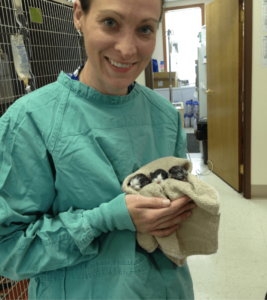 Barks & Recreation is proud to feature Dr. Eileen Savier CVA, CVCH as our Veterinary Blogger in our “From the Vet” Series. Currently part of the team of doctors at Keystone Veterinary Clinic, Dr. Savier is a 2012 Graduate of the Ross University School of Veterinary Medicine, She completed her clinical experience at The Ohio State University and after veterinary school she pursued further education and certification in Veterinary Acupuncture, Chinese Herbal Medicine, and Fear Free veterinary visits. Dr. Savier has a special interest in integrative medicine, animal behavior, and internal medicine and is committed to improving animal health care by integrating Eastern and Western philosophies. She enjoys working with fearful & aggressive dogs and cats and she has had additional training in low stress handling techniques and encourages positive reinforcement during exams and procedures. Her clinical interests include pain management, animal behavior, geriatric patient care, and internal medicine. Dr. Savier is a member of the following associations:
Barks & Recreation is proud to feature Dr. Eileen Savier CVA, CVCH as our Veterinary Blogger in our “From the Vet” Series. Currently part of the team of doctors at Keystone Veterinary Clinic, Dr. Savier is a 2012 Graduate of the Ross University School of Veterinary Medicine, She completed her clinical experience at The Ohio State University and after veterinary school she pursued further education and certification in Veterinary Acupuncture, Chinese Herbal Medicine, and Fear Free veterinary visits. Dr. Savier has a special interest in integrative medicine, animal behavior, and internal medicine and is committed to improving animal health care by integrating Eastern and Western philosophies. She enjoys working with fearful & aggressive dogs and cats and she has had additional training in low stress handling techniques and encourages positive reinforcement during exams and procedures. Her clinical interests include pain management, animal behavior, geriatric patient care, and internal medicine. Dr. Savier is a member of the following associations: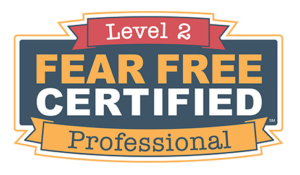
- American Veterinary Medical Association (AVMA)
- International Veterinary Academy of Pain Management (IVAPM)
- American Association of Feline Practitioners (AAFP)
- American Veterinary Society of Animal Behavior (AVSAB)
- American Association of Traditional Chinese Veterinary Medicine (AATCVM)
- Ohio Veterinary Medical Association (OVMA)
Dr. Savier shares her home with two (soon to be three) dogs, two cats, and a toddler. She lovingly refers to her two dogs as Coconut Retrievers as they were rescue dogs she brought home from the island of St. Kitts. In her free time she enjoys spending time with her family, going to the beach, and planning her next Disney vacation.
Join us every month for Dr. Savier’s “From the Vet” series to get more information related to the health and welfare of your furry family members![/vc_column_text][/vc_column][/vc_row]

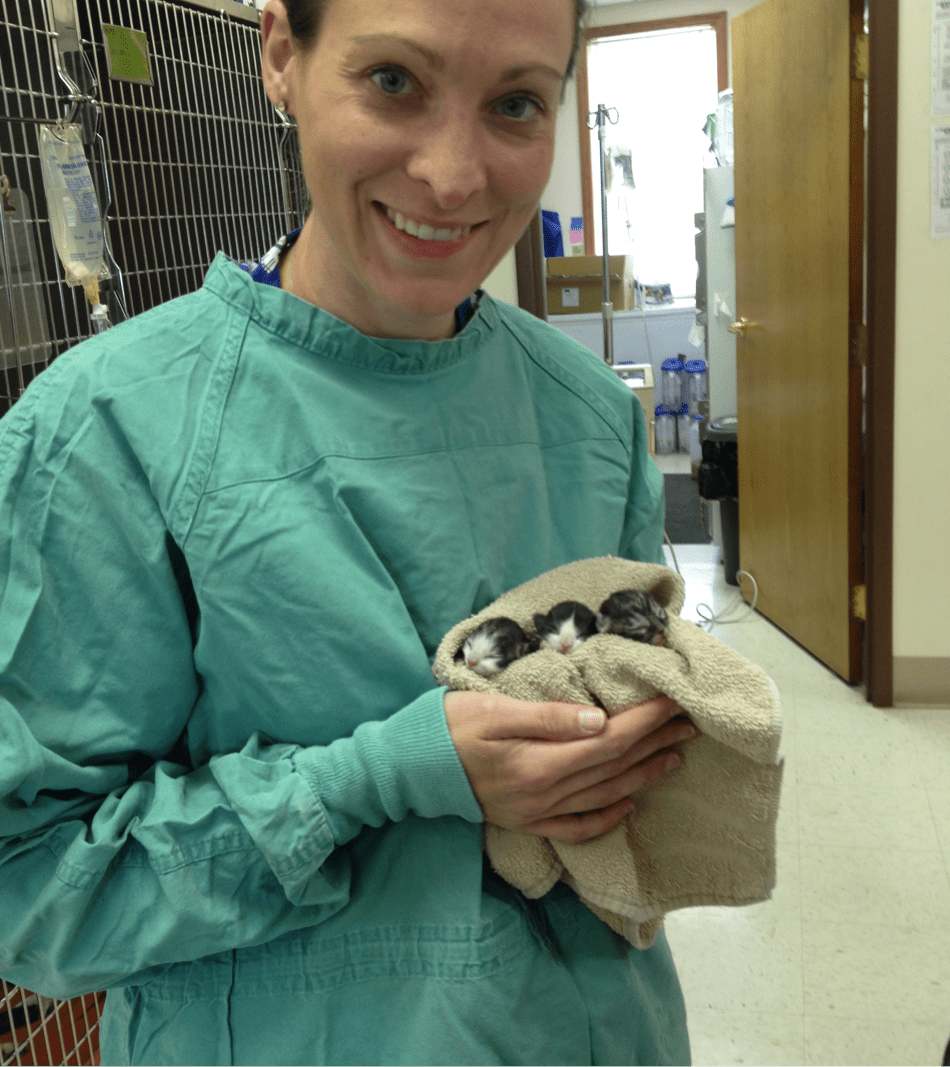 Barks & Recreation is proud to feature Dr. Eileen Savier CVA, CVCH as our Veterinary Blogger in our “From the Vet” Series — offering information related to the health and welfare of your furry family members! Currently part of the team of doctors at Keystone Veterinary Clinic, Dr. Savier is a 2012 Graduate of the Ross University School of Veterinary Medicine, She completed her clinical experience at The Ohio State University and after veterinary school she pursued further education and certification in Veterinary Acupuncture, Chinese Herbal Medicine, and Fear Free veterinary visits. Dr. Savier has a special interest in integrative medicine, animal behavior, and internal medicine and is committed to improving animal health care by integrating Eastern and Western philosophies. She enjoys working with fearful & aggressive dogs and cats and she has had additional training in low stress handling techniques and encourages positive reinforcement during exams and procedures. Her clinical interests include pain management, animal behavior, geriatric patient care, and internal medicine.
Barks & Recreation is proud to feature Dr. Eileen Savier CVA, CVCH as our Veterinary Blogger in our “From the Vet” Series — offering information related to the health and welfare of your furry family members! Currently part of the team of doctors at Keystone Veterinary Clinic, Dr. Savier is a 2012 Graduate of the Ross University School of Veterinary Medicine, She completed her clinical experience at The Ohio State University and after veterinary school she pursued further education and certification in Veterinary Acupuncture, Chinese Herbal Medicine, and Fear Free veterinary visits. Dr. Savier has a special interest in integrative medicine, animal behavior, and internal medicine and is committed to improving animal health care by integrating Eastern and Western philosophies. She enjoys working with fearful & aggressive dogs and cats and she has had additional training in low stress handling techniques and encourages positive reinforcement during exams and procedures. Her clinical interests include pain management, animal behavior, geriatric patient care, and internal medicine.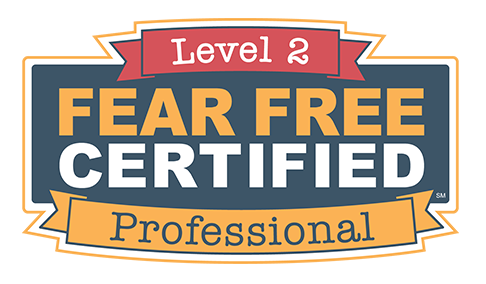 Dr. Savier shares her home with two (soon to be three) dogs, two cats, and a toddler. She lovingly refers to her two dogs as Coconut Retrievers as they were rescue dogs she brought home from the island of St. Kitts. In her free time she enjoys spending time with her family, going to the beach, and planning her next Disney vacation.
Dr. Savier shares her home with two (soon to be three) dogs, two cats, and a toddler. She lovingly refers to her two dogs as Coconut Retrievers as they were rescue dogs she brought home from the island of St. Kitts. In her free time she enjoys spending time with her family, going to the beach, and planning her next Disney vacation.


